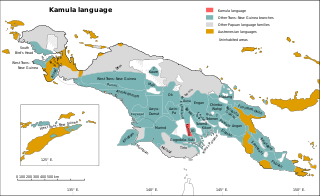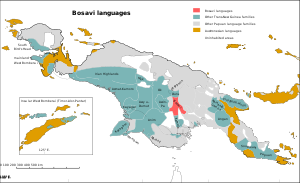
The Papuan languages are the non-Austronesian languages spoken on the western Pacific island of New Guinea, as well as neighbouring islands in Indonesia, Solomon Islands, and East Timor. It is a strictly geographical grouping, and does not imply a genetic relationship.
The Lower Mamberamo languages are a recently proposed language family linking two languages spoken along the northern coast of Papua province, Indonesia, near the mouth of the Mamberamo River. They have various been classified either as heavily Papuanized Austronesian languages belonging to the SHWNG branch, or as Papuan languages that had undergone heavy Austronesian influence. Glottolog 3.4 classifies Lower Mamberamo as Austronesian, while Donohue classifies it as Papuan. Kamholz (2014) classifies Warembori and Yoke each as coordinate primary subgroups of the South Halmahera–West New Guinea languages.
The Border or Upper Tami languages are an independent family of Papuan languages in Malcolm Ross's version of the Trans–New Guinea proposal.
The Piawi languages are a small family of Papuan languages spoken in the Schraeder Range of the Madang Highlands of Papua New Guinea that had been part of Stephen Wurm's Trans–New Guinea proposal. They are now connected to the Arafundi and Madang languages.

The Central Solomon languages are the four Papuan languages spoken in the state of Solomon Islands.
Elseng is a poorly documented Papuan language spoken by about 300 people in the Indonesian province of Papua. It is also known as Morwap, which means "what is it?" ‘Morwap’ is vigorously rejected as a language name by speakers and government officials.
The Pauwasi languages are a likely family of Papuan languages, mostly in Indonesia. The subfamilies are at best only distantly related. The best described Pauwasi language is Karkar, across the border in Papua New Guinea. They are spoken around the headwaters of the Pauwasi River in the Indonesian-PNG border region.

The Kaure–Kosare or Nawa River languages are a small family spoken along the Nawa River in West Papua, near the northern border with Papua New Guinea. The languages are Kaure and Kosare.

The Duna–Pogaya (Duna–Bogaia) languages are a proposed small family of Trans–New Guinea languages in the classification of Voorhoeve (1975), Ross (2005) and Usher (2018), consisting of two languages, Duna and Bogaya, which in turn form a branch of the larger Trans–New Guinea family. Glottolog, which is based largely on Usher, however finds the connections between the two languages to be tenuous, and the connection to TNG unconvincing.

The Kamula–Elevala languages are a small family of the Trans–New Guinea languages spoken in the region of the Elevala River.

The Gogodala–Suki or Suki – Aramia River languages are a small language family of Papua New Guinea, spoken in the region of the Aramia River.

The East Strickland or Strickland River languages are a family of Papuan languages.
The Demta–Sentani languages form a language family of coastal Indonesian Papua near the Papua New Guinea border.

The Yam languages, also known as the Morehead River languages, are a family of Papuan languages. They include many of the languages south and west of the Fly River in Papua New Guinea and Indonesian Western New Guinea.
Mpur is a language isolate spoken in and around Mpur and Amberbaken Districts in Tambrauw Regency of the Bird's Head Peninsula, New Guinea. It is not closely related to any other language, and though Ross (2005) tentatively assigned it to the West Papuan languages, based on similarities in pronouns, Palmer (2018), Ethnologue, and Glottolog list it as a language isolate.

Mor is a nearly extinct Trans–New Guinea language of Indonesia. It is spoken along the Budidi River and the Bomberai River on the Bomberai Peninsula.

Pawaia, also known as Sira, Tudahwe, Yasa, is a Papuan language that forms a tentative independent branch of the Trans–New Guinea family in the classification of Malcolm Ross (2005).

Kamula is a Trans–New Guinea language that is unclassified within that family in the classification of Malcolm Ross (2005). Noting insufficient evidence, Pawley and Hammarström (2018) leave it as unclassified.
Edolo (Etoro) is a Papuan language of Papua New Guinea, spoken by the Etoro people. As of 2015, there were 300 monolingual speakers. It is part of the Bosavi branch of the Trans–New Guinea language family.
Dibiyasoa.k.a.Bainapi is a Papuan language of Western Province, Papua New Guinea.











